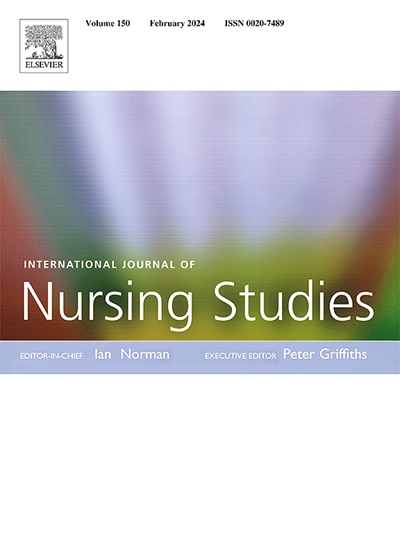Night and shift work and incidence of physician-diagnosed sleep disorders in nursing staff: A prospective cohort study
IF 7.5
1区 医学
Q1 NURSING
引用次数: 0
Abstract
Background
Epidemiological studies provide evidence for an association between shift work and sleep problems but often lack precise exposure and outcome data.
Objective
To investigate the risk of first-time physician-diagnosed sleep disorder in nursing staff using register-based data of shift work and health outcomes.
Design
A prospective cohort study with a 4.5-year follow-up.
Participants
25,639 healthcare employees (nurses including midwives, nursing assistants, and related care professions) employed for at least six months between 2012 and 2016 by Region Stockholm were included.
Methods
Information on hour-by-hour and day-by-day working hours was obtained from a computerised employee register. Physician-diagnosed sleep disorders (N = 326) were obtained from an outpatient register from January 2013 to June 2017. Discrete time proportional hazards models were used to estimate hazard ratios (HR) adjusting for age, sex, country of birth and profession.
Results
An increased risk of physician-diagnosed sleep disorder was seen among those who, during the preceding six months, only or frequently (> 66 times) worked night shifts compared to those who did not work nights (HR 1.70, 95 % CI 1.17–2.43 and HR 1.77, 95 % CI 1.21–2.50 respectively). The associations were supported by a dose–response pattern (p = 0.0006). Among those who work night shifts, the risk associated with 9–12 times of three or more consecutive nights was of borderline statistical significance (HR 1.66, 95 % CI 0.98–2.81). Frequently (> 39 times the last six months) having quick returns from night shifts (< 28 h) showed an almost 2-fold increased risk of physician-diagnosed sleep disorder compared to those who had few (< 8 times in the last six months) quick returns from night shifts (HR 1.89, 95 % CI 1.05–3.52). Quick returns from afternoon shifts in non-night workers (< 11 h) did not significantly increase the risk of physician-diagnosed sleep disorder.
Conclusion
The results indicate that intensive night shift work, especially frequent and consecutive night shifts, is associated with an increased risk of physician-diagnosed sleep disorder in nursing staff. This study raises awareness of the need to acknowledge objective in addition to subjective health outcomes in relation to shift work.
夜班和轮班工作与医生诊断的护理人员睡眠障碍的发生率:一项前瞻性队列研究
流行病学研究为轮班工作和睡眠问题之间的关联提供了证据,但往往缺乏精确的暴露和结果数据。目的利用值班数据和健康结果调查护理人员首次被医生诊断为睡眠障碍的风险。设计一项前瞻性队列研究,随访4.5年。参与者纳入2012年至2016年斯德哥尔摩地区雇用至少6个月的25,639名医疗保健员工(护士,包括助产士、护理助理和相关护理专业人员)。方法从计算机化的员工登记簿中获取每小时和每天的工作时间信息。从2013年1月至2017年6月的门诊登记中获得医生诊断的睡眠障碍(N = 326)。离散时间比例风险模型用于估计调整年龄、性别、出生国家和职业的风险比(HR)。结果:在过去6个月里,仅睡或经常睡的人患医生诊断睡眠障碍的风险增加。66倍)与不上夜班的人相比(HR 1.70, 95% CI 1.17-2.43和HR 1.77, 95% CI 1.21-2.50)。剂量-反应模式支持了这种关联(p = 0.0006)。在那些上夜班的人中,9-12次连续3个或更多的夜晚的风险具有临界统计学意义(HR 1.66, 95% CI 0.98-2.81)。经常(比;过去6个月有39次)夜班后迅速返回(<;与睡眠时间很少(<)的人相比,医生诊断为睡眠障碍的风险增加了近两倍。(过去6个月8次)夜班后快速返回(HR 1.89, 95% CI 1.05-3.52)。非夜班工人下午班的快速回报(<;11小时)没有显著增加医生诊断的睡眠障碍的风险。结论高强度的夜班工作,特别是频繁和连续的夜班工作,与护理人员医生诊断的睡眠障碍的风险增加有关。这项研究提高了人们的认识,认识到除了主观健康结果之外,还需要承认与轮班工作有关的客观健康结果。
本文章由计算机程序翻译,如有差异,请以英文原文为准。
求助全文
约1分钟内获得全文
求助全文
来源期刊
CiteScore
15.00
自引率
2.50%
发文量
181
审稿时长
21 days
期刊介绍:
The International Journal of Nursing Studies (IJNS) is a highly respected journal that has been publishing original peer-reviewed articles since 1963. It provides a forum for original research and scholarship about health care delivery, organisation, management, workforce, policy, and research methods relevant to nursing, midwifery, and other health related professions. The journal aims to support evidence informed policy and practice by publishing research, systematic and other scholarly reviews, critical discussion, and commentary of the highest standard. The IJNS is indexed in major databases including PubMed, Medline, Thomson Reuters - Science Citation Index, Scopus, Thomson Reuters - Social Science Citation Index, CINAHL, and the BNI (British Nursing Index).

 求助内容:
求助内容: 应助结果提醒方式:
应助结果提醒方式:


